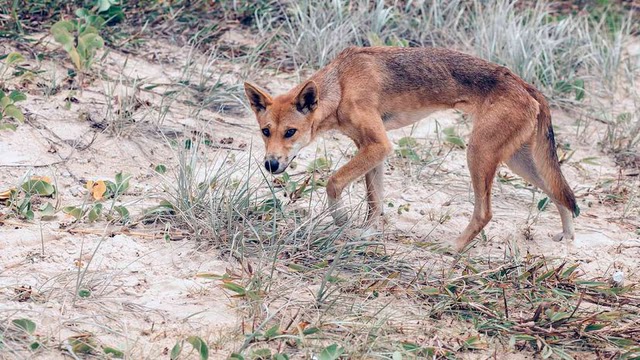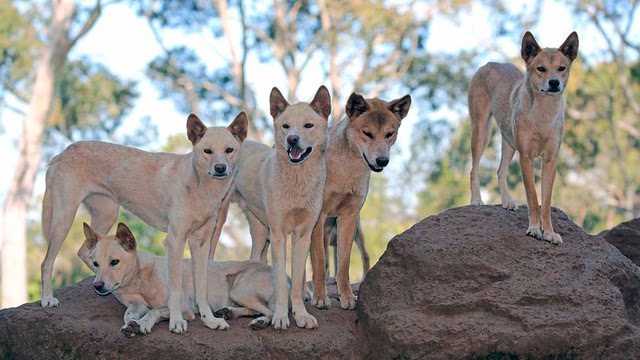Quck answer
Dingoes can be dangerous, especially if they feel threatened or if they are hungry. However, attacks on humans are rare. The infamous case of a dingo killing a baby in Australia in 1980 was controversial and highly debated, with some arguing that the mother had fabricated the story. Nevertheless, it serves as a reminder that dingoes are wild animals and should be treated with caution and respect. It is important to never approach or feed a dingo, keep a safe distance, and secure food and garbage to avoid attracting them.
Wild Animals

A dingo on Fraser Island in Queensland, Australia, is searching for food. SolStock/Getty Images
The phrase “The dingo ate my baby” has been repeated countless times, typically in a poor Australian accent. While it may be amusing to some, few people know the true story behind this less-than-humorous statement. After all, it’s difficult to imagine a scenario in which a baby being eaten could be considered funny.
But let’s set the jokes aside for a moment and examine the topic of dingoes and whether they are a danger to humans. Additionally, we’ll explore how a dingo could have come into contact with a baby in the first place.
What is a Dingo?
Dingoes (Canus lupus dingo) are wild dogs indigenous to Australia that migrated from Southern Asia approximately 3,000 to 4,000 years ago. They are similar in appearance to feral dogs in the United States, but lack the catchy name. Male dingoes are typically lean and weigh between 22 and 44 pounds (11.8 and 19.4 kilograms). They have a reddish, orangish, and goldish coat and pointy ears. Females are slightly smaller, weighing between 21 and 35 pounds (9.6 and 16 kilograms).
Although some dingoes travel alone, most travel in packs. A dominant dingo couple leads the pack, and the pair typically mates for life and breeds within the group. Dingoes breed once per year, and litters typically consist of five pups.
When the dominant female mates, she kills the offspring of her packmates. Afterwards, the other females in the pack help care for the dominant female’s pups because they are the only surviving pups. Dingoes that survive past puppyhood typically live around seven or eight years in the wild and up to 15 years in captivity.

Dingoes travel and hunt in packs led by a dominant dingo couple.
Tier Und Naturfotografie J und C/Getty Images
Dingoes Are Not Like Domesticated Dogs
Dingoes are opportunistic hunters and scavengers. They consume rabbits, rodents, birds, lizards, foliage, nuts, and even babies (too soon?). Much like wolves, they are highly intelligent and smarter than most domesticated dogs (excluding your own, of course). Dingoes are also quite cute but cunning. Unlike domesticated dogs, they have wrists that rotate, which allows them to use their paws much like human hands. Additionally, they have larger canine teeth than domesticated dogs, double-jointed limbs, and can turn their necks 180 degrees. Dingoes are also capable of running quickly, climbing easily, and jumping high. They also howl like wolves. This information may be useful for future camping trips!
Despite their intelligence, humans generally view dingoes as pests. This contentious relationship dates back to 1788, when the British first brought sheep to New South Wales, providing dingoes with a new source of easy prey. By the 1880s, dingoes were infiltrating farms and rural communities. The solution was the construction of the “dingo fence,” a 3,500-mile (5,632-kilometer) fence that stretches across Australia. The fence still stands today and is the longest in the world.
The population of pure dingoes has decreased as many have interbred with feral and domesticated dogs, as well as hybrids.
According to Michelle Ferguson, who works at Brevard Zoo in Melbourne, Florida, dingoes are currently considered “vulnerable” due to interbreeding with dogs that bring in new diseases. However, they are protected in Australia. Pure dingoes can still be found on Queensland’s Fraser Island, but they are wild and have been involved in tragic incidents with humans due to their predatory nature. The “dingo fence,” which is the world’s longest fence, was built to keep native dingoes away from sheep farms in the outback of Australia.
One of the most well-known incidents involving dingoes and humans occurred in 1980 when Lindy Chamberlain’s 10-week-old baby, Azaria, was taken from their tent by a dingo while camping near Ayer’s Rock in the Northern Territory. The incident was initially met with disbelief, and Lindy was ultimately tried and found guilty of murder. However, in 1986, her conviction was overturned when Azaria’s jacket was found near a dingo lair. In 2012, the coroner officially ruled that Azaria’s cause of death was due to being taken by a dingo. Since then, there have been several more documented cases of dingoes attacking and killing children.
In 1981, Michael and Lindy Chamberlain held a photo of their baby daughter, Azaria Chamberlain, on the steps of the Alice Springs courthouse after a coroner’s inquest concluded that a dingo had taken their baby. The infamous line “The dingo ate my baby” became part of pop culture thanks to a 1991 episode of the sitcom “Seinfeld.” In the episode, Elaine imitates a fake-Australian accent and says the line to a woman who annoyingly keeps saying she can’t find her fiancГ© (baby) at a party.
FAQ
1. Are dingoes dangerous?
Dingoes are wild dogs that are native to Australia. Like any wild animal, they can be dangerous, especially if they feel threatened or cornered. However, dingoes are generally shy and will avoid humans if possible. In areas where dingoes have become habituated to humans, they may become more aggressive in their search for food.
2. Did a dingo really eat a baby?
Yes, there was a highly-publicized case in 1980 where a 9-week-old baby named Azaria Chamberlain disappeared from a campsite in Australia. Her parents claimed that a dingo had taken her, but were initially not believed by authorities. The case became known as the “dingo baby” case and was the subject of much controversy and speculation. In 2012, a coroner officially ruled that a dingo was responsible for the baby’s death.
3. How often do dingoes attack humans?
There are very few documented cases of dingoes attacking humans. In most cases, dingoes will avoid contact with humans if possible. However, there have been some incidents where dingoes have attacked people, especially if they feel threatened or if they are habituated to humans and have become more aggressive.
4. What should you do if you encounter a dingo?
If you encounter a dingo, it’s important to remain calm and keep a safe distance. Do not approach the dingo or attempt to feed it. If the dingo appears aggressive or is acting strangely, you should back away slowly and avoid turning your back on it. If you are camping in an area where dingoes are known to be present, you should take precautions like storing food securely and not leaving children unattended.
5. How can you tell if a dingo is aggressive?
Some signs that a dingo may be aggressive include growling, snarling, baring its teeth, and standing with its ears pointed forward. If a dingo is exhibiting any of these behaviors, it’s important to back away slowly and avoid turning your back on it.
6. Do dingoes hunt in packs?
Dingoes are generally solitary animals, but they may form loose packs for hunting purposes. These packs are usually made up of a mated pair and their offspring. In areas where dingoes have become habituated to humans, they may also form larger packs in search of food.
7. What do dingoes eat?
Dingoes are opportunistic hunters and scavengers. They will eat a variety of prey, including kangaroos, wallabies, rabbits, and birds. They will also scavenge from human sources, such as garbage and food left out in campsites.
8. Are dingoes a threat to livestock?
Yes, dingoes are considered a threat to livestock in areas where they are present. They may attack and kill sheep, goats, and other livestock. In some areas, dingoes are culled in an effort to protect livestock.
9. Are dingoes endangered?
Dingoes are not currently considered an endangered species, but they are protected in some areas of Australia. However, there is concern that hybridization with domestic dogs may be diluting the genetic purity of dingoes and threatening their long-term survival.





Leave a Reply